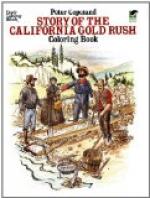[Illustration: Father Junipero Serra.]
Drake and his sailors repaired and refitted their vessel during the month they stayed at Drake’s Bay. They made several trips inland also and saw the pine and redwood forests with many deer feeding on the hills; but they did not discover San Francisco Bay. On leaving New Albion, Drake sailed the Golden Hind across the Pacific to the East Indies and the Indian Ocean, and round the Cape of Good Hope home to England, with all the treasure he had taken. The queen received him with great honors and his ship was kept a hundred years in memory of the brave admiral, who had commanded it on this voyage.
During the next century several English commanders of vessels sailed the South Sea while hunting Spanish galleons to capture, and these ships often touched at Lower California for fresh water. Some of the captains explored the coast and traded with the Indians, but no settlements were made.
Then the Spanish tried to find and settle the country they had heard so many reports of, thinking to provide stations where their trading ships might anchor for supplies and protection. Viscaino, on his second voyage for this purpose, landed at San Diego in 1602. Sailing on to the island he named Santa Catalina, Viscaino found there a tribe of fine-looking Indians who had large houses and canoes. They were good hunters and fishermen and clothed themselves in sealskins. Viscaino went on to Monterey and finally as far north as Oregon, but owing to severe storms, and to sickness among his sailors, he was obliged to return to Mexico.
For a long time after this failure to settle upon the coast, the Spanish came to Lower California for the pearl-fisheries. Along the Gulf of California were many oyster-beds where the Indians secured the shells by diving for them. Large and valuable pearls were found in many of the oysters, and the Spanish collected them in great quantities from the Indians who did not know their real value.




